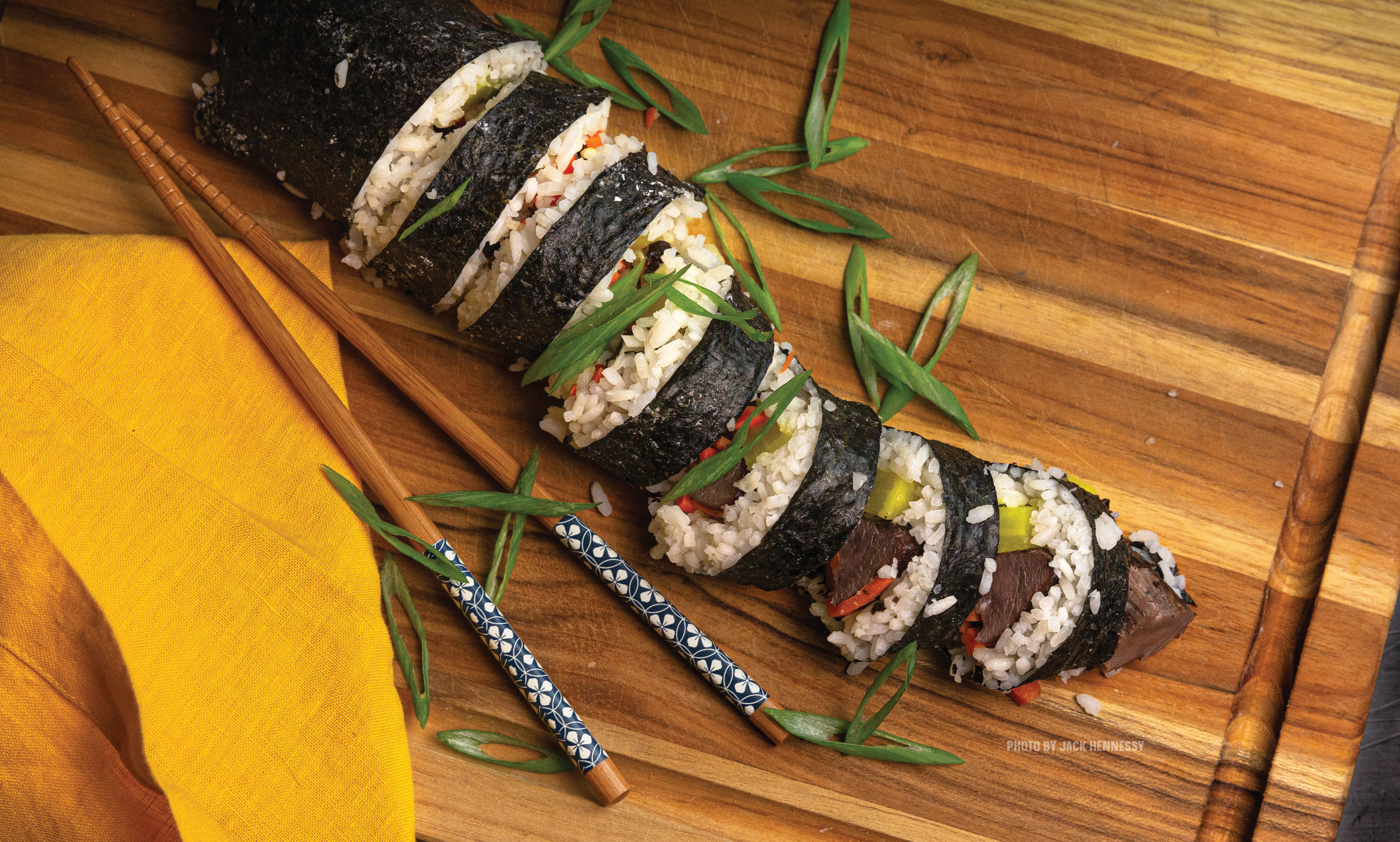Gimbap — also spelled “kimbap,” depending on the source, with a pronunciation that is between the two, said “keem-baap” — is not sushi, though it looks a lot like sushi. Sushi owes its origin to Japan, while gimbap has Korean roots and is a dish made from cooked rice, vegetables, sometimes fish or meat and rolled in gim — dried sheets of seaweed. It gets sliced and served like a sushi roll, but will often include pickled vegetables and sometimes grilled meats — in this case, venison.
Making both sushi and gimbap rolls can be hard to explain, so you may wish to search for an instructional video. It make take a bit of practice, but even if your roll isn’t perfect, it’ll still taste good.

Gimbap is also a great way to make use of cold venison, as gimbap can be served as a cold snack (and often is at Korean grocers). Pickled yellow radish can be found at Korean grocers, but if having trouble locating, add extra marinated cucumber and carrot instead, maybe a bit of roasted kale.
Ingredients: (serves 4)
12 to 16 ounces venison
Kosher salt
Freshly cracked black pepper
2 cups sushi rice
2 cups cold water
1/3 cup rice vinegar
1 tablespoon sugar
1/4 teaspoon kosher salt
Pickled yellow radish (danmuji) cut into strips
1 cucumber, seeded and cut into thin strips
1 carrot, cut into thin strips
1/4 cup rice vinegar
1/2 cup Mirin sweet cooking rice seasoning
1/4 teaspoon sesame oil
Minimum of 10 sushi nori or gim dried seaweed sheets
Directions:
1. Peel and seed cucumber and slice both cucumber and carrot into very thin strips and marinate strips for at least a couple hours in mix of 1/4 cup rice vinegar, 1/2 cup Mirin, and 1/4 teaspoon sesame oil.
2. Cook any cut of venison to medium-rare and let cool. Slice into 1/4-inch-thick and 8-inch-long strips (or however long your nori sheet is). Goal here is to have uniform width with strips so you don’t have any gaps in gimbap roll after rolling. Also, yes, you can stack strips one after another to fill length of nori sheet, but you do run slight risk of an empty pocket somewhere along the roll after cutting.
3. To make the sushi rice, using a sieve, rinse 2 cups of sushi rice under cold water for a couple minutes. Add the sushi rice to a medium saucepan with 2 cups cold water and cover. Bring to a boil then immediately drop to low heat. Keep covered for 20 minutes or until all water is absorbed. In a separate pan, simmer the rice vinegar with sugar and salt until the sugar and salt dissolves. Turn off heat. After all water has been absorbed by the sushi rice, in a large mixing bowl, add both the sushi rice and the mixture of rice vinegar, sugar, and salt. Mix thoroughly and leave out until ready to roll gimbap.
4. To make a gimbap roll, use either rough or shiny side of nori sheet—your choice—and add a 1/4 inch of sushi rice across the sheet. It may help to have a bowl of cold water nearby to quickly rinse off your fingertips as they may get sticky while adding the rice. Feel welcome to use a wooden spatula to help spread the rice. Add the ingredients lengthwise to the rice. If making a fatter gimbap roll, you’ll want your ingredients vertical with the shortest nori sheet side, meaning you’ll have more room to roll. If making a thinner roll, resulting in more pieces, add the ingredients parallel to the longest side of the nori sheet.
5. Roll the gimbap roll tightly then place on bamboo mat and form tightly again a few times. (For tips on making and roll sushi, Google the video with Iron Chef Morimoto). To cut, use a very sharp knife and lightly wet with water or spray with cooking oil to avoid sticking. Cut roll in half, then each half in half, then each piece in half until you have 8 to 10 pieces. Garnish with drizzle and sliced scallions. Enjoy!
Reach out to me on Instagram (@WildGameJack) with any questions or comments.
View this post on Instagram

